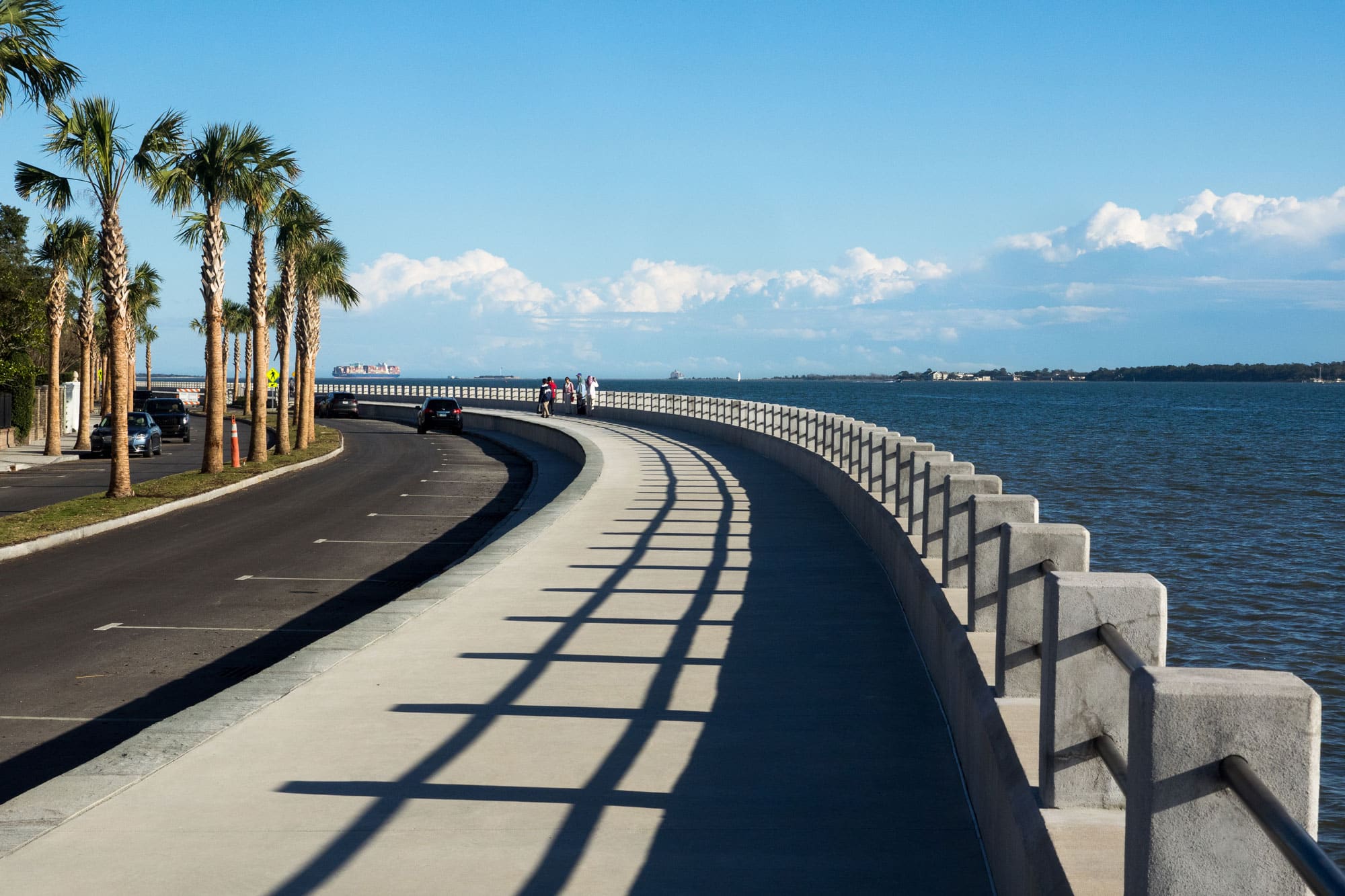Processing loss on foot in South Carolina’s Historic City
My feet ached as I walked toward the southern end of Charleston. I was moving at a steady clip along the elevated Battery, a stone seawall built in the 19th century to protect the city from storm surges and invading naval forces. On one side was the tidal channel of the Ashley River. On the other, a long line of antebellum mansions. In the distance, a hulking container ship inched out to sea.
It was a sunny afternoon, the week before Christmas. The city felt surprisingly empty, even for the winter off-season in Low Country. I’d only covered a few miles so far, but my total for the past month was over 200. Much of this mileage came during long walks around this historic peninsula, trying to take my mind off things. When my wife and I first began exploring Charleston on foot, we’d park in the free spots on Murray Boulevard, which parallels the Battery. Now I parked my truck at the university hospital, where my mom remained bedridden in worsening condition. Between wrenching morning and evening visits, I took to the streets for grueling 10-mile marches through history.
At the tip of the peninsula, I stopped as usual at White Point Garden. With a canopy of oak trees, sporadic palms, and a series of commemorative monuments, it’s one of Charleston’s most attractive parks. I made my way to a curious patch of disturbed ground. Most pedestrians pass through the park unaware that it may be part of a 40-year-old mystery.
The Hunt for a Secret
In 1982, an eccentric publisher named Byron Preiss released The Secret: A Treasure Hunt. The book includes linked poems and artworks offering clues to the location of twelve treasure casques buried in city parks around the U.S. Each casque contains a key that could be redeemed for a jewel from Preiss. The puzzles proved harder than expected, and only two were unearthed during his lifetime, one in Chicago’s Grant Park in 1983 and another in Cleveland’s Greek Garden in 2004.
Preiss died in a car accident in 2005 without revealing the remaining locations. Fourteen years later, a third casque was found in Boston, leaving nine unaccounted for. Some may have been destroyed or discovered without notice. Others may still be found, and Preiss’ estate claims it will honor the prize. During my walks, I noticed signs of searching in the sandy soil of White Point Garden. But it’s important to mention that digging is prohibited. Instead, I found it a welcome distraction to just ponder the clues.
“Hear the cool, clear song of water,” reads one verse, perhaps a reference to nearby fountains or the vast Charleston Harbor. Other clues come from the painting. The large lion might signify the royal crest of the English king for whom Charles Town was named when founded in 1670. Several map-like illustrations depict the land masses and waterways surrounding the city. One pentagonal shape closely matches a top-down outline of Fort Sumter, which was visible out in the bay.
“Beside the long palm’s shadow,” reads another line, which might refer to one of the tall sabal palmettos rising high above the park. The final line may reference the stark-white mansion of Villa Margherita, located across So. Battery Street, with fluted columns closely resembling the president’s residence in Washington, D.C.: “White house close at hand.”
After an engrossing pass through the park, I resumed my walk. North along the Battery wall and east down the cobblestone street of So. Adgers Wharf to reach Waterfront Park. Here I rested sore legs on one of the public piers offering views of grassy wetlands and the modern cable-stay bridge over the Cooper River. I had hours to go, so why rush? The reason for these exhausting sessions was that if I didn’t walk, I couldn’t sleep. I would lie awake in my motel, ruminating about my mom’s condition. Reading about rare symptoms and obscure diagnoses.
A Mysterious Illness
Three years ago, I was conducting fieldwork in the slot canyons of Arizona for my recent book Discovering the Outlaw Trail when word came my mom wasn’t well. When I visited her in Northern California, I expected Covid but instead found her in a strangely weakened state from some unknown illness.
For a week, she became increasingly incoherent. During a monthlong hospitalization, the doctors were baffled by her bizarre state. They suggested it was time for hospice. We told them no. Since I wasn’t allowed to visit due to pandemic lockdowns, I coordinated over the phone.
At one point, an observant young resident realized she hadn’t been fed amid the chaos. After receiving an emergency feeding tube, she began to revive. Yet the mysterious condition lingered. It was something neurological but otherwise uncertain. Each time the doctors settled on a diagnosis and treatment plan, something unexpected would happen.
The result was a hellish three years of specialists, hospital stays, and nursing facilities. Midway through, my wife and I moved my mom out to live with us in South Carolina. To manage her care, I did extensive research to navigate a labyrinth of doctors’ opinions. Through trial and error, we found medications that helped. She made strides at times, like ditching a walker for a cane her first month out here. We went on walks around the neighborhood, along the riverfront, to a nearby wildlife refuge. But, always, there were more downs than ups. A tremor in one hand gradually spread to all four extremities. At night, she’d sometimes yell out in distress from the shaking. She became increasingly confused and struggled to communicate.
A year ago, my mom decided she needed around-the-clock care. We moved her to a friendly assisted-living facility in an oak grove near our house. Despite new discoveries, her decline continued. In early November, we saw the most horrific development yet. She was found in the common room with every muscle in her body spasming simultaneously. The first hospital couldn’t solve the issue, nor could the second, so she was transferred by ambulance to Charleston.

Historic Sites to Walk To
From Waterfront Park, I turned into the heart of the old town. My mom has always loved historic buildings and churches, so I snapped photos to show her my discoveries. Pink House is believed to be the oldest building in the city. Located at 17 Chalmers St. in the French Quarter, it was likely constructed sometime during the 17th century. Over the years, it became a tavern, brothel, law office, art gallery, and private residence. It’s not open to the public, but the quaint cobblestone street is worth visiting.
A few doors down is the Old Slave Mart Museum, which documents the stories of enslavement, auctioning, and emancipation of African Americans in this colonial port city. Next, I backtracked south of Broad Street to see some architectural highlights that the horse-drawn carriage tours visit. Then I went north, passing under the impressive steeple of St. Philip’s Church. The next spot is the Old City Market, which extends for three blocks. Established in the late 1700s, it was originally filled with food merchants but today has mostly gift shops.
I continued west to the main commercial thoroughfare of King Street, with its many bars and restaurants. A half mile north led to Marion Square, which has lights during the holiday season. Around this point, I typically added some mileage by aiming for dinner at a downtown brewery. The closest are Rusty Bull and Charleston Beer Works, a taphouse, on King Street. That said, I’ve also trekked miles north to Palmetto Brewing and, once, all the way to local favorite Edmund’s Oast.
On my way back to the hospital, I detoured through the picturesque College of Charleston, where centuries-old live oaks are draped in Spanish moss. I sat on a bench and stared up at the twisty branches. For all our advanced knowledge, so much remains beyond our grasp.

Unforgettable Steps
High above the city, on the 9th-floor neurology wing, I walked down the long hallway. I never knew what to expect upon entering my mom’s hospital room. Tonight, she was thankfully sleeping. Other times, I found her writhing in agony.
Her recurring episodes resembled seizures but were not epileptic. The neuro team’s initial plan was to sedate her while conducting tests and researching obscure conditions. But after nearly three weeks, the doctors meekly admitted they didn’t know what was happening. Some unknown disorder not yet recognized by modern medicine. The emergency feeding tube would have to come out soon, and she was too weak to consume enough calories on her own. The next step was likely hospice.
Not everyone had given up. Most importantly, my mom continued to fight. She gasped out short responses. Tried to eat. Struggled to rise and focus on the photos I shared. The nurses and I had found small remedies to ease her discomfort, including damp cloths and giving her ice cubes. The physical therapists were the best allies.
“She will surprise you,” I said during the first week. “If you give her the chance.”
With their help, my mom had struggled to her feet. Her weight was down to maybe 90 pounds. Yet she staggered the entire length of the hallway and back. Everyone on the floor looked up. Their faces were a mix of concern, admiration, and shock at her determination.
Each day, I carried a backpack filled with three years’ worth of health records, professional opinions, peer-reviewed articles, and notes. Before we gave up, I rallied everyone who would listen—nurses, physical therapists, and a few receptive members of the dozen-doctor team.
There was a faint pattern to her mysterious illness. During three years of recurring downs and ups, we tried numerous medications. There was a type of brain stabilizer that helped several times. The symptoms were very different back then, but who’s to say this wasn’t a new manifestation of the same disorder? The doctors didn’t seem to appreciate the outside input.
We don’t believe it will work, they repeatedly said.
“Everyone’s just guessing,” I countered. “You’ve admitted you don’t know what’s happening.”
Our debate devolved into a shouting match, during which I showed them photos of my mom from the past six months. Before this latest crisis, she could eat. Walk with a cane. Have visits. Stunned by the contrast to her current state, they agreed.
This will be the last attempt, whispered a specialist who was doubtful but admitted the uncertainty. She probably has just days to weeks left.

Holiday Walks
The days around the holidays were the hardest of all. I walked laps like the locals at scenic Colonial Lake, a reflecting pool surrounded by stately homes. I trudged north to Hampton Park, the largest and nicest in Charleston, with a variety of forested paths. I wandered through the castle-like campus of the Citadel. As Christmas arrived, so did the visitors and that holiday mix of cheerfulness and public meltdowns. Some families stomped down the street, openly arguing. Others meandered happily along the cobblestones.
Some evenings, I made miles across West Ashley, from my motel to restaurants and brewpubs. My favorite was the German-inspired Charles Towne Fermentory. One night, I was sitting at a bar, downcast, when some friendly locals sat next to me. After learning why I was in town, they practically carried me across the street to The Roost, where they took turns cheering me up.
What increasingly haunted me during my long walks around town was no longer my mom’s incurable condition. It was the common refrain: say what you need to say before it’s too late. I spent hours thinking about these words. Yet whenever I sat with her in the hospital, I couldn’t bring myself to say them. I didn’t want to alarm her, which could trigger the episodes. I didn’t want her to give up before she was ready.
The Beginning of the End
Within 24 hours of starting the final medication, my mom showed surprising signs of improvement. The feeding tube was removed. She began speaking again, just a few words here and there. She managed to eat, mostly protein shakes. The physical therapists helped her sit and stand, but she was too weak to walk. The nurses were impressed, and the doctors reluctantly agreed. There was a slim chance of recovery.
A few days after Christmas, I was back home, waiting for my mom’s return by ambulance to the facility. The hospital called. Her airway began to collapse overnight, said a doctor. We have her on oxygen. You need to come now. I drove south in a daze. Rushed from parking garage to elevator and down the long hallway.
“Oh no, she’s blue,” I blurted when I saw the tint of her skin underneath the oxygen mask. This is it, I thought. I need to speak now. I sat down next to her and grasped her hands.
“You made me tough, mom,” I said. “And that’s how I’ve been able to fight for you these three years.”
Suddenly, I was sobbing and had to stop.
“I love you so much,” I gasped, trying to hold it together. “I’m not very good at this. I’m so sorry we couldn’t figure it out. But I am so proud of how hard you’ve fought.”
My mom took a breath. A moment later, she took a deeper one. Then another. Slowly, the pale blue tint faded from her face. For an hour, her oxygen levels rose. Her normal color returned. Hospital staffers stepped in to look. She surprised us one last time.
Throughout the day, she grew stronger. By afternoon, the nurse sent me on my last long walk around Charleston. I spent the night in a chair holding my mom’s hand. The next day, I followed the ambulance to her facility, where we turned her room into a hospice. The medication had helped, but she’d become too weak to recover. Instead, she had some final visits with family and friends. From the time the doctors said she had days to weeks, she lasted nearly two months.
Before she passed away at the beginning of February, my mom and I spent long hours together. We watched old movies before her sight failed. We reminisced, with me doing the talking. She uttered brief replies before losing the ability to speak.
“We went to Yosemite,” I said, rattling off our best times. Point Reyes. Muir Woods. Lake Tahoe. We rafted the Klamath. Hiked in Tilden. Rowed boats in Golden Gate Park. I always loved when we went to Fort Point. We didn’t do as much as we hoped these last few years, but we had some good times. We walked the neighborhood, the riverfront, the refuge.
“I hope it was nice for you,” I said tearfully.
“Yes,” she gasped with all her strength. “It was beautiful.”
Cover photo: The Battery, along the Ashley River. All photos by the author







